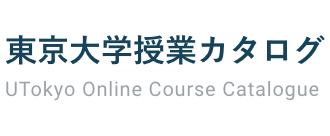学内のオンライン授業の情報漏洩防止のため,URLやアカウント、教室の記載は削除しております。
最終更新日:2025年4月21日
授業計画や教室は変更となる可能性があるため、必ずUTASで最新の情報を確認して下さい。
UTASにアクセスできない方は、担当教員または部局教務へお問い合わせ下さい。
最終更新日:2025年4月21日
授業計画や教室は変更となる可能性があるため、必ずUTASで最新の情報を確認して下さい。
UTASにアクセスできない方は、担当教員または部局教務へお問い合わせ下さい。
都市基盤技術I
都市災害軽減工学E/Urban Disaster Mitigation Engineering
地震をはじめとするハザードが引き起こす様々な障害に関して,都市化地域の抱える問題点との関係から分析/議論し,都市災害を軽減する対策に関する課題と解決策を掘り下げて考える.
Various impacts due to natural hazards, such as earthquakes and floods, etc. in urban areas will be analyzed considering the problems generated by urbanization of the area. Based upon the analysis, issues and solutions for establishing proper countermeasures for disaster mitigation and management will be discussed.
Various impacts due to natural hazards, such as earthquakes and floods, etc. in urban areas will be analyzed considering the problems generated by urbanization of the area. Based upon the analysis, issues and solutions for establishing proper countermeasures for disaster mitigation and management will be discussed.
時間割/共通科目コード
コース名
教員
学期
時限
08D1448
FAS-DA4F49L3
都市基盤技術I
目黒 公郎
未定
講義使用言語
英語
単位
2
実務経験のある教員による授業科目
NO
他学部履修
可
開講所属
教養学部
授業計画
受講者数によって、学生発表の時間が変わるので、講義形式のコマ数は変化する可能性があるが、基本的な講義計画は下記のとおりである。
最初の数回(4回程度):座学による総合的な災害マネジメントの説明、キーワードの洗い出し,調査項目,資料の調査法,まとめ方などに関する講義。
8回程度:各学生による調査発表。毎回数人が発表し、その後に討論する。
最後の回:すべての学生発表の総括と講義全体にわたる統合討論。
Depending on the number of students taking the course, the time used for students' presentation may change, so the number of lectures by instructors may change. But the basic lecture plan is as follows.
First few times (about 4 times): Lectures by instructors on comprehensive disaster management system, keyword identification, how to investigate, and make presentation materials.
About 8 times: Student's presentation and discussion.
Final class: Summary of all student presentations and integrated discussion throughout the lecture.
授業の方法
最初の数回(4回程度)は、座学による総合的な災害マネジメントの説明、キーワードの洗い出し,調査項目,資料の調査法,まとめ方などに関する講義を行う。その後の8回程度は、受講者ごとに課題を決め,その課題についての調査/分析結果を発表してもらい,その結果に基づく総合討論を自由に展開するスタイルが基本.最近都市化地域に発生した自然災害による被害とその対応などの分析を軸とする.更に防災館(本所防災館)の見学を実施し,防災訓練と災害の疑似体験をしてもらう.受講者が取りくむ課題の例としては、都市化地域の自然災害の特徴と地域特性,構造物被害と人的被害,間接被害/産業に与える影響,被害想定と地域防災計画,ライフライン防災対策,災害リスクマネージメント・クライシスマネジメント,防災教育,東京が抱える防災の課題などがある.
The first few sessions (around 4 sessions) will be lectures on comprehensive disaster management, including identifying key words, survey items, methods of collecting data, and how to compile information. For the next about 8 sessions, students will be asked to choose a topic, make a presentation on the results of their survey/analysis on that topic, and then engage in a free general discussion based on the results. The final session will be a summary of the course and final discussion.
The focus will be on the analysis of damage caused by recent natural disasters in urbanized areas and responses to them. In addition, students will be given a tour of the Disaster Prevention Center (Honjo Disaster Prevention Center), where they will be given a disaster prevention training and a simulated disaster experience.
Followings are the potential topics that the students will tackle and make a presentation
Probable damage in Tokyo due to future earthquakes,
Regional characteristics of the damaged areas and proper recovery,
Structural damage/reconstruction/ retrofit,
Human casualties and life after the hazard (including disaster preparedness and recovery of life),
Risk management and disaster information system,
Damage to lifelines,
Business interruption/ disaster insurance, BCM/BCP
Training and education for disaster management,
Fire and firefighting, and
Urban renewal.
成績評価方法
最終的な成績は下記の6項目を総合して評価する。
1)講義への出席状況、2)講義における積極的な質疑、3)プレゼンテーション(独自に調査した内容を報告してもらう)の、4)他の学生の発表の講義ノート作成、5)最終レポートの提出、6)防災訓練施設への見学会への参加。
The final grade will be determined based on the following six points:
1) Attendance at lectures, 2) Contribution for discussion during lectures, 3) Presentation (students will be asked to report on their own research topics), 4) Note making on other students' presentations and discussion, 5) Submission of a final report, and 6) Participation in a tour of a disaster training center.
教科書
教科書はない。 No Textbook.
参考書
ない。 Nothing
履修上の注意
講義内で伝える。It will be informed at the class.
その他
授業開催場所は、下記の通り。
生産技術研究所のAs棟のAs311.312講義室。
シラバスの基本情報には、「先端研As棟(45号館)」の記載があるが、これは間違い。
The location of the class is as follows:
Room As311 and 312, 3F of As Building of the Institute of Industrial Science (IIS) (IIS is located at Komaba II Campus.)
The basic information in the syllabus says "As Building of the Institute of Advanced Science (Building No. 45)", but this is incorrect.
実務経験と授業科目の関連性
関係ない。No relation.





 学部後期課程
学部後期課程

 マイリストに追加
マイリストに追加
 マイリストから削除
マイリストから削除


